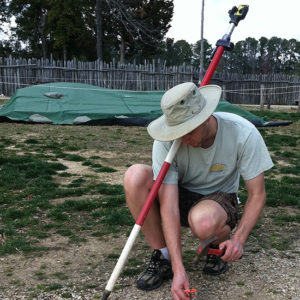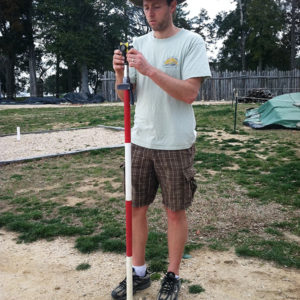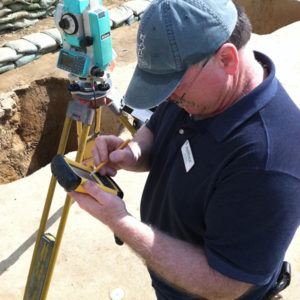The field crew has begun to prepare for an April return to the James Fort site excavations. One of the main objectives of the 2012 season is to explore an area west of the brick church tower and north of the recently rediscovered 1608 church, the first substantial church built at Jamestown. In 2009 excavations north of this unexplored area uncovered the edge of an archaeological feature that appeared to date to the James Fort period (ca. 1607-24) and could extend into this season’s exploration zone. On the map to the left, the golden yellow square marks the location of the first 10’ x 10’ square likely to be dug this year. We already know there is modern fill above the James Fort level. Once that is removed we should be able to define the size of the feature.
The first archaeological 10’ x 10’ grid square of the season has been staked out using the laser transit. This machine allows us to program into it the coordinates of the four corners of an archaeological grid square. After the laser transit establishes the accurate point for a corner, a gutter spike with flagging tape is hammered into the ground. This process is repeated four times until all corners are staked out, at which point a string is tied between all four nails to establish the grid square limits for the excavators to follow.
Archaeologists have begun to take inventory of their other equipment to make sure that wheelbarrows, screens, shovels, etc. are in good working order before heading back outside. The John Deere tractor is undergoing some maintenance as it will be needed to move some modern fill.
This month’s video update describes a mysterious iron object found in one of the 1608 church’s postmolds last summer as it travels from the field to the lab. The artifact continues to undergo conservation.
related images
- Danny Schmidt Hammering Excavation-Unit Corner Nails
- Senior Staff Archaeologist Danny Schmidt Holding Stadia Rod
- Staff archaeolologist Dan Smith using laser transit








